Famous Pharmacists
07 Jun . 21 min read.

Pharmacy has a long history in the United Kingdom and the rest of the world, with remedies ranging from opium to peppermint used across the globe for thousands of years. There are many successful and famous pharmacists notable in history who have been the discoverers and creators of important medicines and remedies which are used to treat patients every day in modern day Britain. Some pharmacists have also been creators and discoverers of other non related pharmacy ideas and products too.
The Pharmacist Cooperative have decided to produce a Continual Professional Development Article on the most Famous Pharmacists to date. We hope this will help with your CPD and that it will enhance your knowledge on Pharmacy History.
Sir Jesse Boot – The founder of Boots Pharmacy
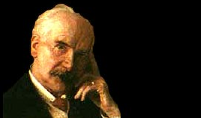
Image Source: http://www.bbc.co.uk/nottingham/features/2002/11/great_nottinghamians_sir_jesse_boot.shtml(1)
Boots is one of the oldest and most well-known healthcare brands on the British high street and its roots have been based in Nottingham for over 160 years. Boots began its journey as a local herbalist store and it precipitously grew into the country’s largest chemists’ chain (2).
Sir Jesse Boot was born in Nottingham in 1850 into a poor, working class family (1-3). His father, John Boot was a purveyor of herbal medicines. The family opened a small shop in Nottingham in 1849 (1 year before Sir Jesse Boot was born) and started to sell herbal medicines and remedies, many of which were made from plants that grew locally. It was the first herbalist store in Nottingham offering affordable traditional medicines (2-3).
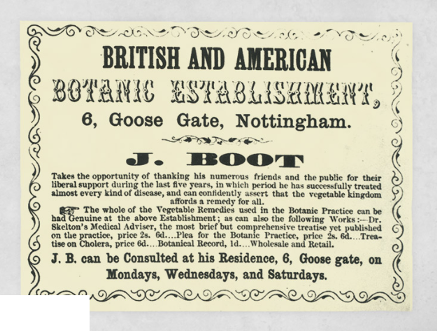
Image Source: https://www.boots-uk.com/about-boots-uk/company-information/boots-heritage/ (4)
Sadly, Jesse’s father passed away in 1860 when Jesse was only 10 years old. Jesse’s mother Mary (with the help of her friends) continued with the business and Jesse started to help her with it also. He even left school at age 13 and devoted himself to the business by helping his mum however he could and working in the shop full time. He would often accompany Mary to gather plants from the countryside which would be used in the shop to make herbal remedies (3-5). The sale of herbs was a large feature of the early business and it included the selling of roots, plants and flowers that were sourced locally and then processed (e.g. dried, pressed or powdered) at the back of the shop (3-5).
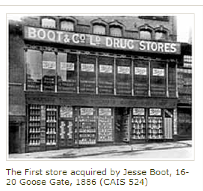
Image Source: http://www.nottsheritagegateway.org.uk/themes/boots.htm (2)
As Jesse grew up, he increasingly began to take control of the management of the store. In his spare time, he studied Pharmacy. Jesse was rewarded with a partnership in the business in 1871 at the age of 21 and the business became known as ‘Mary & Jesse Boot – Herbalists’ (2-3).
From an early age Jesse had a vision for expanding the business far beyond the small confines of Goose gate, Hockley and Nottingham. Jesse had a sound grasp of business principles (3-4). As time progressed, interest in patented medicines was increasing via advertising. Driven by social injustice, Jesse took up the role of “Trade Reformer” and created a new system of healthcare. Jesse’s methods were simple; he bought in bulk, paid in cash and reduced his profit margins (3-5). This meant he was able to offer his customers medicines at affordable prices. His biggest and best-selling item was Boots ‘No Name Ointment’.
In 1884 Jesse opened his first shop outside of Nottingham, which was in Sheffield. It is in this year that Jesse also appointed his first externally qualified pharmacist, named Edwin Waring. Jesse and Edwin’s vision for company expansion were closely aligned (1-5). After building the brand further, Jesse then branched into medicines manufacturing and built Boots factories. By 1900 Boots stored appeared all over the country (4-5). Jesse Boot was knighted for his phenomenal success (including his work in and devotion to pharmacy and the Boots brand) in 1909 (4-6). In 1933 a new Boots factory was built in Beeston which still stands today (4-5).

Image Source: https://www.thevintagenews.com/2017/02/13/john-pemberton-the-inventor-of-coca-cola-died-penniless-and-addicted-to-morphine/ (6)
Coca-Cola is probably the most recognisable drink in the world, as the curvy trademark bottles filled with the famous black liquid daily reach every corner of the world (6). In May 1886, Dr John S. Pemberton, a pharmacist in Atlanta, Georgia, created the syrup for Coca-Cola (7). He carried a jug of the new product down the street to Jacobs' Pharmacy in Atlanta, USA. There, it was sampled, deemed "excellent" and it was placed on sale as a soda fountain drink for five cents per glass (7). Carbonated water was mixed with the new syrup to produce the soda fountain drink and it was branded at once as "Delicious and Refreshing," a theme that continues to resonate today wherever Coca‑Cola is advertised and sampled (6-9).
Born January 8, 1831 in Knoxville, Georgia, Pemberton earned his medical degree at age 19 from the Reform Medical College of Georgia in Macon. Pemberton then went on to acquire a graduate degree in Pharmacy. Pemberton fought in the American Civil War as a soldier of the Confederate army and he served as an officer for almost the entire duration of the civil war before he created the famous drink Coca-Cola. In April 1865, Pemberton fought in the Battle of Columbus which is by many regarded as the last battle of the Civil War (6-9b).
Pemberton opened his own drug store in Columbus, Georgia.
After acquiring an injury during his service in the war, Pemberton turned to the addictive medicine morphine to ease his pain (9). As time elapsed, Pemberton began to experiment with opium-free medicines, as he was conscious that his morphine addiction was a dangerous habit. When another doctor claimed he could cure opium habits with coca (cocaine), Pemberton devised his own concoction, which used coca leaves and kola nuts. Pemberton called this French Wine Coca. A local prohibition law was enacted in 1886, therefore Pemberton was forced to remove the alcoholic element from his French Wine Coca recipe and his new non-alcoholic formula thus became Coca-Cola (6-9b).
Pemberton’s bookkeeper Frank Robinson suggested the name Coca-Cola (he advised that the brand should employ 2 Cs in Coca-Cola instead of using Coca-Kola )and he also developed the script style that remains the company’s logo. During the company’s early years, the Coca-Cola formula was altered numerous times. Until 1905, it contained extracts of cocaine and the kola nut. After this date, cocaine was subsequently removed and citric acid was added instead along with a variety of fruit flavours (8-9b).

Image Source: https://www.coca-cola.com/gb/en/about-us/history#:~:text=On%20May%208%2C%201886%2C%20Dr,countries%20and%20territories%20each%20day.(9c)

Image Source: https://www.sciencedirect.com/sdfe/pdf/download/eid/1-s2.0-S0898140X15369639/first-page-pdf
Friedrich Sertürner was a German pharmacist and a pioneer of alkaloid chemistry (10). Hi research led to the discovery of morphine in 1804. Sertürner was an outstanding chemist who significantly influenced the transformation of pharmaceutical chemistry (from a state of alchemy) to an acknowledged branch of science at the end of the 18th century (11). At the young age of 21, Sertürner was the first person to report on some results concerning a substance which was thought to be responsible as the "sleeping-agent". This substance had been isolated by himself from the poppy plant. This Repeated analysis led to Sertürner finding crystallisable properties of the agent in 1817, which he then named morphine (10-11).
To gain a deeper understanding of the effects of the drug, Sertürner was able to confirm the hypnotic as well as the analgesic properties of morphine via further studies and scientific investigations (11). Nowadays the practice of medicine and pharmacy is practically impossible without morphine and morphine has promoted further scientific discovery e.g. further development of pharmaceutical chemistry and experimental pharmacology (12).
Sertürner life work not only led to the discovery of morphine but it also pioneered and promoted a new branch of science that came to be known as alkaloid chemistry. This initiative led to the isolation of numerous other alkaloids such as codeine, quinine, strychnine, veratrine and emetine (11-11b).

URL: https://scienceline.org/2009/08/environment-ortlip-poppies-opium-climate-change/ (11c)
Stewart Adams and John Nicholson – Discovery of Ibuprofen
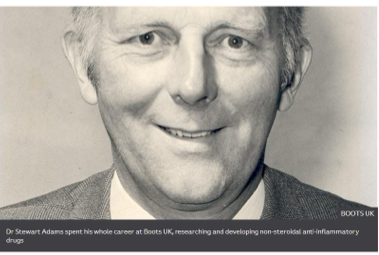
Image source: https://www.bbc.co.uk/news/health-34798438 (12)
Ibuprofen is now available globally to treat pain and is also used to treat inflammatory arthritis. It is also used in the treatment for rheumatoid arthritis. Ibuprofen was discovered by the Pharmacists Stewart Adams and chemist John Nicholson (12-13).
Stewart Adams gained a degree in pharmacy at Nottingham University followed by a PhD in pharmacology at Leeds University, before he returned to the research department at Boots Pure Drug Company Ltd in 1952. Adams’ goal at that time working at Boots was to discover or create a new treatment for rheumatoid arthritis which was as effective as a steroid treatment but without any of the unwanted side-effects that steroid treatment can often bring to the table (13). He started looking at anti-inflammatories, particularly aspirin and the way it worked.
In 1953 Adams and chemist John Nicholson began work to identify an analogue of aspirin that might be suitable for long-term use for rheumatoid arthritis. The key was to find a drug that would be well tolerated (14). From the front room of an old Victorian house in Nottingham, the team patiently tested and re-tested compounds until they found one that was worth trying on/ testing on patients in the clinic. Eight years on and 600 chemical compound candidates had been screened. Adams and Nicholson filed a patent in 1961 for the compound 2-(4-isobutylphenyl) propionic acid, later to be called ibuprofen. The patent was granted the following year (13-15).
The drug discovery process continued with clinical trials being set up in 1966 in Edinburgh. Ibuprofen was administered to 6 patients with rheumatoid arthritis. By1969, Ibuprofen was launched in the UK for treatment of rheumatic diseases and marketed as prescription medicine Brufen at a dose of 600–800mg per day (13-15). Ibuprofen compared favourably with standard treatment for rheumatoid arthritis (aspirin) because it was deemed to have a better gastrointestinal side-effect profile.
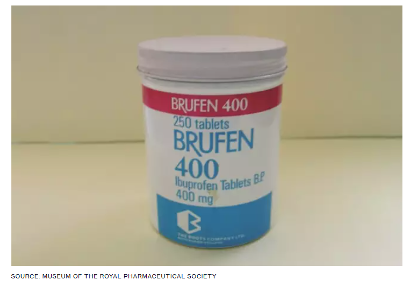
Image Source: https://pharmaceutical-journal.com/article/infographics/a-brief-history-of-ibuprofen (13)
As further testing went on, mild to moderate pain was added as an indication for ibuprofen in the UK and it is now available as an over-the-counter medication for a wide range of ailments (15).
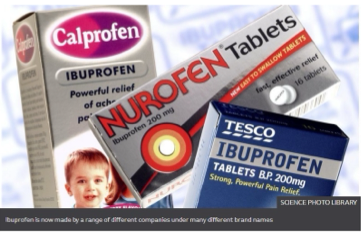
Image Source: https://www.bbc.co.uk/news/health-34798438 (12)
Dr Adams received an OBE for his work in the 1980s and in 2013 he was made an Honorary Freeman of the City of Nottingham (15).
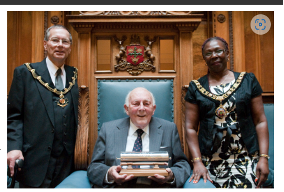
Image Source: https://blogs.nottingham.ac.uk/newsroom/2019/01/31/dr-stewart-adams-obe-nottinghams-best-alumni-passes-away-aged-95/ (15)
Marie Curie
Marie Curie has made significant contributions to the world of pharmacy and radio pharmacy. Marie Curie is most famous for her discovery of radium and polonium, and her vast and phenomenal contribution to finding treatments for cancer. Marie Curie was born on 7th November 1867 in Warsaw (under the Russian Empire) which is now Poland. She was born into a family of teachers who believed strongly in education and training. After completing general education in local Polish schools and some scientific training from her father, Marie Curie moved to Paris in 1891 to continue her studies. It is in Paris where she met her future husband Pierre Curie, who was a Professor in the School of Physics department (16-22).
Marie Curie is famous for her work on radioactivity and she is a twice a winner of the Nobel Prize (16,20).
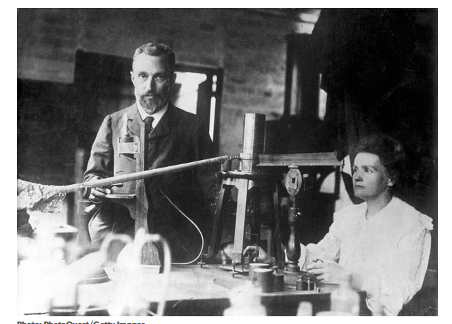
Image Source: https://www.biography.com/scientists/marie-curie-biography-facts (21)
Marie Curie was the first woman to ever win a Nobel Prize and she is the only woman to win the award in two different fields (Physics and Chemistry) (16, 20).
Overall, Marie Curie was awarded 2 Nobel Prizes in her lifetime:
1. Marie Curie was awarded half of the 1903 Nobel Prize for Physics alongside her husband Pierre Curie. The 1896 discovery of radioactivity by French Physicist and Engineer Henri Becquerel (who won the other half of the 1903 Nobel prize) inspired Marie and her husband to further investigate this phenomenon.
The prize was awarded to Curie and her husband "in recognition of the extraordinary services they have rendered by their joint researches on the radiation phenomena discovered by Professor Henri Becquerel" (20-20c).
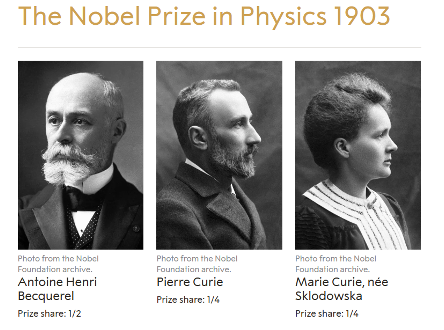
Image Source: https://www.nobelprize.org/prizes/physics/1903/summary/ (20b)
2. Marie Curie was also sole winner of the 1911 Nobel Prize for Chemistry.
This was in "in recognition of her services to the advancement of chemistry by the discovery of the elements radium and polonium, by the isolation of radium and the study of the nature and compounds of this remarkable element".
Quote Source: https://www.nobelprize.org/prizes/chemistry/1911/summary/ (20c)
Research Outline
Together with her husband, Curie examined many substances and minerals for signs of radioactivity. They discovered that the mineral pitchblende (an amorphous, black, pitchy form of the crystalline uranium oxide mineral uraninite) was more radioactive than uranium and concluded that it must contain other radioactive substances (21-23, 27).
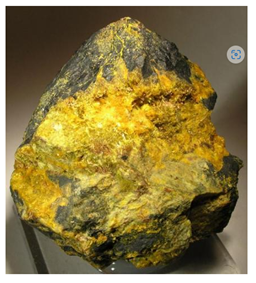
Pitchblende- Image Source: https://ahf.nuclearmuseum.org/ahf/history/uranium-mining/ (27)
From pitchblende, Marie and Pierre Curie then managed to extract two previously unknown elements, polonium and radium, both more radioactive than uranium.
Marie Curie named the first chemical element she discovered ‘polonium’ after her home country Poland.
Curie then proceeded to develop methods for the separation of radium from radioactive residues in sufficient quantities to allow for its characterization and the careful study of its properties (21-27).
Therapeutic Properties of Radium
Curie focused and intensified her work on the therapeutic properties of radium. Marie and Pierre discovered that their new found elements radium and polonium could be used to destroy tissue. This led to their discovery that radium could be used to kill cancer cells and in extension this enabled a way of treating cancerous tumours (24-26).
Throughout her life, Curie actively promoted the use of radium to alleviate suffering. During World War one alongside her daughter (Irene Curie), she personally devoted herself to this remedial work (21, 24-26).
Radiation treatment is now one of the main treatments for cancer. Modern radiation treatments are more targeted, resulting in better and improved treatment. Treatment of cancers has improved substantially over the years with surgical removal of tumours and chemotherapy to kill cancer cells also being used in cancer treatment alongside radiation when appropriate. Cancer still remains a major problem in today’s society, however an increased number of types of cancers are being cured and controlled by these treatments (24-26, 28).
Marie Curie Charity

Image Source: https://www.mariecurie.org.uk/
Marie Curie is the UK’s leading end of life charity. They help patients by providing information and support, hospice care and companion volunteers (29).
The charity’s origins are linked to the Marie Curie Hospital, at 2 Fitzjohn's Avenue, Hampstead. It was staffed by medical women and it had the capacity to care for 700 patients a year in 39 beds, with facilities for radium and x-ray therapy. It also included modern pathological and research laboratories. Madame Marie Curie (the scientist who discovered polonium and radium in 1898) was most interested in the project and allowed her name to be given to the hospital (29-31).
The hospital was opened in 1923 by Prime Minister Stanley Baldwin. The ceremony was attended by both the Polish and the French Ambassadors, representing the native and adopted countries of Marie Curie. It specialised in the "radiological treatment of women suffering from cancer and allied diseases" (29-31).
X-Rays
Marie Curie's research was also crucial in the development of X-rays in surgery. During the First World War, Marie Curie worked to develop and install small, mobile X-ray units that could be used to diagnose injuries near the battlefront. This technology was invaluable to doctors on the front line (19-21, 25).
Curie also helped to equip ambulances with X-ray equipment, which she herself personally drove to the front lines. The International Red Cross made her head of its radiological service and Curie taught educational training courses for doctors and support staff on X-ray technology.
Giving doctors the capability to X-ray wounds saved thousands of lives during World War One and the practicality, success and effectiveness of this technology lead to civilian use of X-ray technology, particularly in hospitals by hospital doctors during and after the war (19, 25-26).
Death
Marie Curie was known to carry around test tubes of radioactive radium in the pocket of her lab coat, not realising that it was having a detrimental effect on her health. She sadly died on 4 July 1934 from leukaemia. It is thought that this was caused by exposure to high-energy radiation from her experiments and scientific research.
By the late 1920s her health was beginning to deteriorate. She died on 4 July 1934 from leukaemia, caused by exposure to high-energy radiation from her research (19-22).
Unusual Facts
· Marie Curie played a vital role in getting 200 X-ray units into field hospitals and 20 mobile X-ray vehicles to the front lines. French troops nicknamed these petites Curies (little Curies) (26).
· Marie Curie’s daughter, Irene Curie went on to win a Nobel prize (jointly with her husband Frédéric Joliot) in 1935 in ‘recognition of their synthesis of new radioactive elements’. In 1938 Irene Curie’s research on the action of neutrons on the heavy elements, was an important step in the discovery of uranium fission (26-28).
Agatha Christie
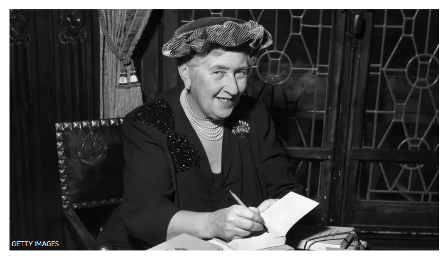
Image Source: https://www.bbc.co.uk/news/uk-england-oxfordshire-67272899 (32)
An unusual name on this list of famous Pharmacists is Dame Agatha Christie, also known as The Queen of Crime. Christie was one of the bestselling novelists of all time and she authored 66 detective novels, 14 short story collections and more than 20 plays. Some of her famous story characters included Detective Hercule Poirot and also Miss Marple. Many of her most well-known works have been adapted into films, including Murder on the Orient Express, Sad Cypress and Death on the Nile (32-35).
Agatha Christie was born on September 15th 1890 in Torquay, Devon. Agatha Christie’s knowledge of poisons was certainly exceptional. Few other novelists can claim to have been read by pathologists as reference material in real poisoning cases. Many people are not aware of the reason to why Christie’s knowledge on poisons and medicines was so substantial.
Christie actually began writing detective fiction novels while working as a nurse and pharmacist during World War I. In the First World War, Christie volunteered as a nurse at her local hospital in Torquay. Christie enjoyed the work but when a new dispensary opened at the hospital it was suggested that she might work there instead. Her new role required further training, and Christie became a pharmacist in 1915 (35-37).
An education in pharmacy not only helped Christie attend to patients during the First World War, but also aided her creative pursuits in literature.
Agatha Christie’s first novel was called The Mysterious Affair at Styles and it involved the poisoning of a victim with strychnine. Her novel Sad Cypress involved an overdose of the drug morphine being administered through, it is thought, fish paste on sandwiches. However, it is later gleaned that instead, it was actually served in a pot of tea (34 & 38).
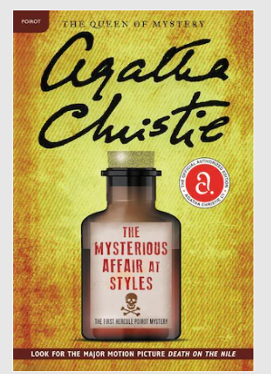
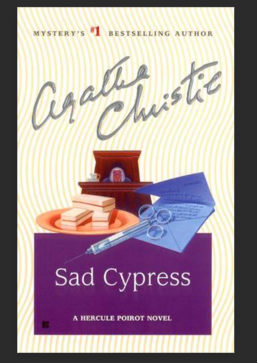
Image Source: https://www.agathachristie.com/stories/the-mysterious-affair-at-styles (38)
Image Source: https://www.goodreads.com/review/show/1628556922 (39)
Sir James Black
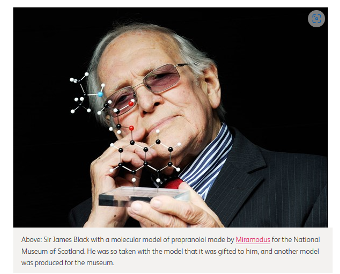
Image Source: https://www.nms.ac.uk/explore-our-collections/stories/science-and-technology/sir-james-blacks-nobel-prize-medal/ (40)
Sir James Black was one of the most talented Scottish scientists of the modern era. His work in medicine and pharmacology has improved the quality of life for millions of people across the globe. He was born in Glasgow and studied at St Andrews University (40).
In 1962, following four years of painstaking hard work, Sir James Black invented propranolol, the first commercially successful beta-blocker. This was marketed as Inderal. James Black also discovered cimetidine.Cimetidine was a spectacular commercial success. Cimetidine is a drug that reduces gastric acid secretion and is used to treat various conditions such as benign duodenal ulceration, gastric ulceration, NSAID-associated ulceration (40-42).
In 1988 Sir James Black was awarded the Nobel Prize for Physiology or Medicine for his outstanding scientific work. He was given this honour ‘for the development of principles which led to his invention of two major drugs, propranolol, a beta-blocker used for the treatment of coronary heart disease, high blood pressure and heart failure, and cimetidine, used in the treatment of stomach ulcers’. Quote Source: https://www.nms.ac.uk/explore-our-collections/stories/science-and-technology/sir-james-blacks-nobel-prize-medal/ (40)
Worcestershire sauce is possibly the city of Worcester's most famous product.
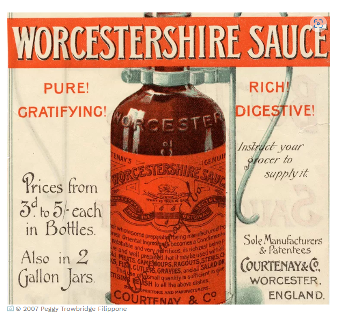
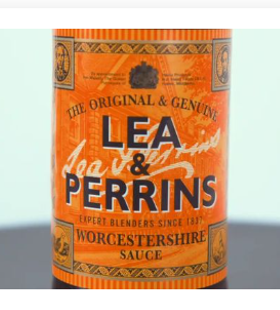
Image Source: https://www.thespruceeats.com/worcestershire-sauce-history-1807686
https://www.pinterest.co.uk/pin/208291551503431966/
It was first produced in Worcester by two chemists named:
· John Wheeley Lea
· William Perrins
The sauce first went on sale in 1837 and it is still produced in the city of Worcester today. The BBC has even produced a radio programme entitled The Worcestershire Sauce Factory Tour. The link to this can be found below:
https://www.bbc.co.uk/programmes/p0c06nkg (44)
History:
It is believed that a local aristocrat who had been Governor of Bengal, visited the chemist shop of Lea and Perrins asking for a recipe he had found in India to be recreated. Lea and Perrins produced an extra jar for themselves, but found they did not like the sauce concoction and hence they stored it in their cellar. After some time, Lea and Perrins retasted the accidentally forgotten potent sauce and they found it to be delicious. To this day the exact recipe of Worcester Sauce has never been revealed by the original purveyors of this upscale condiment, Lea & Perrins. However, most of the ingredients are listed on the products sold in shops (43, 45).
The original bottle shows the ingredients to be:
· barley malt vinegar
· spirit vinegar
· molasses
· Sugar
· Salt
· Anchovies
· Tamarind extract
· Onions
· Garlic
· Lemons
· Soy sauce
· Pickles
· Peppers
· Unspecified spices and flavourings (43, 45)
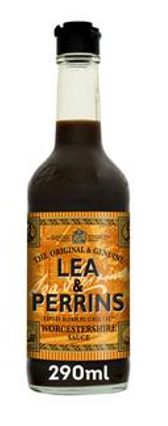
Image Source: Lea & Perrins Worcestershire Sauce 290ml | Sainsbury's (sainsburys.co.uk)
John Walker
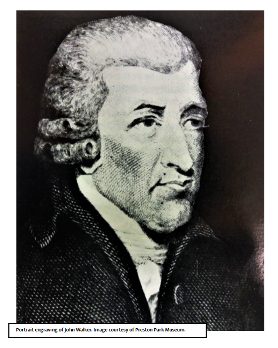
Image Source: https://teesvalleymuseums.org/blog/post/john-walker-and-the-friction-match/ (47)
Sometimes, the best inventions happen by chance. In 1826, John Walker a curious chemist in Stockton on Tees, discovered through a lucky accident that a chemical coated stick he had been toying with suddenly burst into flames when scraped across his stone fireplace. He went on to invent the first friction match (46-49).
Until the first half of the nineteenth century, the process by which fire was created was slow and painstakingly laborious. John Walker's friction match revolutionised the production, application and the portability of fire.
Walker sold his first ‘Friction Light’ on the 12th April 1827 from his pharmacy in Stockton on Tees (46-49).
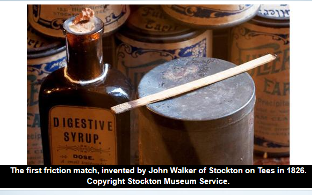
Image Reference: https://www.bbc.co.uk/ahistoryoftheworld/objects/hQR9oN5LTeCLcuKfPDMJ9A (49)
How Matches Function
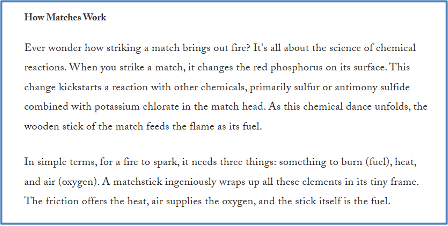
An extract explaining the basic principles of how matches work for your reference.
Reference: https://yourstory.com/2023/08/john-walker-matchstick-accidental-invention-history (46)
Thank You for taking the time to read this CPD Article.
By Priya Ved
References
1. BBC- Great Nottinghamians. Sir Jesse Boot. [Internet]. Accessed December 2023.
URL:http://www.bbc.co.uk/nottingham/features/2002/11/great_nottinghamians_sir_jesse_boot.shtml
2. The Nottinghamshire Heritage Getaway. Boots Overview,
By Sophie Clapp. [Internet]. Accessed December 2023.
URL: http://www.nottsheritagegateway.org.uk/themes/boots.htm
3. Benefactors of University College – Sir Jesse Boot. University of Nottingham. [Internet]. Accessed December 2023.
4. Boots Heritage @ Boots.com. [Internet]. Accessed December 2023.
URL: https://www.boots-uk.com/about-boots-uk/company-information/boots-heritage/
5. The National Portrait Gallery. Jesse Boot, 1st Baron Trent.
6. The Vintage News. John Pemberton, the inventor of Coca-Cola, died penniless and addicted to morphine. By Domagoj Valjak.
7. The Coca-cola company: How was Coca-cola invented. [Internet]. Accessed December 2023.
URL: https://www.coca-colacompany.com/faqs/how-was-coca-cola-invented
8. Lemelson-mit. John Pemberton, Coca-cola , consumer devices.
URL: https://lemelson.mit.edu/resources/john-pemberton
9. The Pharmacy Times. 5 Facts About Famous Pharmacist John Pemberton, Coca-Cola Inventor. By Meghan Ross. [Internet]. Accessed December 2023.
URL: https://www.pharmacytimes.com/view/5-facts-about-famous-pharmacist-john-pemberton-coca-cola-inventor
9b. John Pemberton. 1831-1888. New Georgia Encyclopaedia. [Internet]. Accessed December 2023.
URL: https://www.georgiaencyclopedia.org/articles/business-economy/john-stith-pemberton-1831-1888/
9c. Our History. Coca-cola. Coca-cola.com. 2023. [Internet]. Accessed December 2023.
10. Science Direct. 125th Anniversary of the Discovery of Morphine by Sertürner. By P.J.HanzlikM.D.https://www.sciencedirect.com/science/article/abs/pii/S0898140X15369639
11. Pubmed. [Friedrich Wilhelm Adam Sertürner−the discoverer of morphine]
[Article in German]. By M Goerig 1 , J Schulte am Esch
URL: https://pubmed.ncbi.nlm.nih.gov/1786314/
11b. The isolation of morphine by Serturner. Chandrasekhar, K and Rai, S. Indian Journal of Anaesthesia. National Library of Medicine. 2016.
URL: https://www.ncbi.nlm.nih.gov/pmc/articles/PMC5125194/
11c. Warming World, Potent Poppies. Science Line. 2009.
URL: https://scienceline.org/2009/08/environment-ortlip-poppies-opium-climate-change/
12. BBC News: The hangover that led to the discovery of ibuprofen. [Internet]. Accessed December 2023.
URL: https://www.bbc.co.uk/news/health-34798438
13. The Pharmaceutical Journal. A brief history of ibuprofen. By Dawn Connelly. [Internet]. Accessed December 2023.
14.
URL: https://pharmaceutical-journal.com/article/infographics/a-brief-history-of-ibuprofen
15. The British Medical Journal. Stewart Adams: pharmacologist who discovered ibuprofen. By Marika Davies. [Internet]. Accessed December 2023.
URL: https://www.bmj.com/content/364/bmj.l898
16. Anscombe, Charlotte. Dr Stewart Adams OBE – Nottingham’s ‘best alumnus’ – passes away aged 95. The University of Nottingham Blog Post. 2019. [Internet]. Accessed December 2023.
17. Marie Curie Facts. Nobelprize.org. Nobel Prize Outreach. 2023. [Internet]. Accessed December 2023.
URL: https://www.nobelprize.org/prizes/physics/1903/marie-curie/facts/
18. 100 Years Ago: Marie Curie Wins 2nd Nobel Prize. Scientific American, November 25, 1911, Volume 105. 2011. [Internet]. Accessed December 2023.
URL: https://www.scientificamerican.com/article/curie-marie-sklodowska-greatest-woman-scientist/
19. Marie Curie -Polish-born French physicist. The Editors of Encyclopaedia Britannica. 2023. [Internet]. Accessed December 2023.
URL: https://www.britannica.com/biography/Marie-Curie
20. Who was Marie Curie?. BBC Bitesize. 2023. [Internet]. Accessed December 2023.
URL: https://www.bbc.co.uk/bitesize/topics/zd4dy9q/articles/z6bnd6f
21. Marie Curie Biographical. The Nobel Prize.org. From Nobel Lectures, Physics 1901-1921, Elsevier Publishing Company, Amsterdam, 1967. 2023. [Internet]. Accessed December 2023.
URL: https://www.nobelprize.org/prizes/physics/1903/marie-curie/biographical/
20b. The Nobel Prize in Physics 1903. The Nobel Prize.org. 2023. [Internet]. Accessed December 2023.
URL: https://www.nobelprize.org/prizes/physics/1903/summary/
20c. The Nobel Prize in Chemistry 1911. The Nobel Prize.org. 2023. [Internet]. Accessed December 2023.
URL: https://www.nobelprize.org/prizes/chemistry/1911/summary/
22. Marie Curie: 7 Facts About the Groundbreaking Scientist. Famous Scientist. Women’s History. 2020. [Internet]. Accessed December 2023.
URL: https://www.biography.com/scientists/marie-curie-biography-facts
23. Marie Curie (1867 - 1934). BBC History. 2023. [Internet]. Accessed December 2023.
URL: https://www.bbc.co.uk/history/historic_figures/curie_marie.shtml
24. Pitchblende mineral. The Editors of Encyclopaedia Britannica. 2023. [Internet]. Accessed December 2023.
URL: https://www.britannica.com/science/pitchblende
25. Marie Curie the scientist. Mariecurie.org.uk. 2023. [Internet]. Accessed December 2023. URL: https://www.mariecurie.org.uk/who/our-history/marie-curie-the-scientist
26. Dronsfield, A & Ellis, P. Radium - a key element in early cancer treatment. 2011. [Internet]. Accessed December 2023.
URL: https://edu.rsc.org/feature/radium-a-key-element-in-early-cancer-treatment/2020217.article
27. Attempts to treat and cure illness and disease. Marie Curie and the development of radiation. BBC Bitesize. 2023. [Internet]. Accessed December 2023.
URL: https://www.bbc.co.uk/bitesize/guides/zwkm97h/revision/6
28. Uranium Mining. Atomic Heritage Foundation. National Museum of Nuclear Science and History. 2018. [Internet]. Accessed December 2023.
URL: https://ahf.nuclearmuseum.org/ahf/history/uranium-mining/
29. 100 Years Ago: Marie Curie Wins 2nd Nobel Prize. Scientific American. November 25, 1911, Volume 105. 2023. [Internet]. Accessed December 2023.
URL: https://www.scientificamerican.com/article/curie-marie-sklodowska-greatest-woman-scientist/
30. Marie Curie. What we do. 2023. [Internet]. Accessed December 2023.
URL: https://www.mariecurie.org.uk/who/what-we-do
31. Marie Curie. Our History. 2023. [Internet]. Accessed December 2023.
URL: https://www.mariecurie.org.uk/who/our-history
32. LOST HOSPITALS OF LONDON. Marie Curie Hospital for Cancer and Allied Diseases. 2023. [Internet]. Accessed December 2023.
URL: https://ezitis.myzen.co.uk/mariecurie.html
33. Allard, David & Stephens, Daisy. Agatha Christie: Lifting the veil on the Queen of Crime. BBC News. 2023. [Internet]. Accessed December 2023.
URL: https://www.bbc.co.uk/news/uk-england-oxfordshire-67272899
34. Poisons Used in Agatha Christie's Mystery Novels. Owl Location. 2023. [Internet]. Accessed December 2023.
URL: https://owlcation.com/humanities/The-Poisons-of-Agatha-Christe
35. Barros, Rute. How Agatha Christie Revolutionised The Use of Poison in Crime Stories. Medium. 2021. [Internet]. Accessed December 2023.
36. Murder Isn’t Easy: The Forensics of Agatha Christie by Carla Valentine review – science and skullduggery. The Guardian. 2021. [Internet]. Accessed December 2023.
37. Top 10 underrated Agatha Christie novels. The Guardian. 2020. [Internet]. Accessed December 2023.
URL: https://www.theguardian.com/books/2020/oct/07/top-10-underrated-agatha-christie-novels
38. 5 Pharmacist Facts About Agatha Christie. The Pharmacy Times. 2015. [Internet]. Accessed December 2023.
URL: https://www.pharmacytimes.com/view/5-pharmacist-facts-about-agatha-christie
39. The Mysterious Affair at Styles. The Home of Agatha Christie. [Internet]. Accessed December 2023.
URL: https://www.agathachristie.com/stories/the-mysterious-affair-at-styles
40. Good Read’s Reviews. Sad Cypress. [Internet]. Accessed December 2023.
URL: https://www.goodreads.com/review/show/1628556922
41. Sir James Black’s Nobel Prize Medal. National Museums Scotland. Science and Technology. . [Internet]. Accessed December 2023.
42. Maulik SubirKumar. The discovery of beta-blockers. Research Gate. Curriculum in Cardiology. Department of Pharmacology, AIIMS, New Delhi, India. 2018. [Internet]. Accessed December 2023.
URL: https://www.researchgate.net/publication/324948213_The_discovery_of_beta-blockers
43. The British National Formulary. Drug Monograph. Cimetidine. 2023. [Internet]. Accessed December 2023.
URL: https://bnf.nice.org.uk/drugs/cimetidine/
44. Fillippone, Peggy. Origin and History of Worcestershire Sauce. The Spruce Eats. 2019. [Internet]. Accessed December 2023.
URL: https://www.thespruceeats.com/worcestershire-sauce-history-1807686
45. Worcestershire Sauce Factory Tour. BBC.co.uk. 2022. [Internet]. Accessed December 2023.
URL: https://www.bbc.co.uk/programmes/p0c06nkg
46. Worcestershire Sauce. The History of the World. The British Museum. BBC.co.uk. [Internet]. Accessed December 2023.
URL: https://www.bbc.co.uk/ahistoryoftheworld/objects/mcraSW4BRJyBTtOMbcb6Tw
47. The Accidental invention of matchsticks. Sparks that changed the world. Yourstory.com. 2023. [Internet]. Accessed December 2023.
URL: https://yourstory.com/2023/08/john-walker-matchstick-accidental-invention-history
48. John Walker and the friction match. Teesvalleymuseums.org. 2023. [Internet]. Accessed December 2023.
URL: https://teesvalleymuseums.org/blog/post/john-walker-and-the-friction-match/
49. Eschner, K. Friction Matches Were a Boon to Those Lighting Fires–Not So Much to Matchmakers. Smithsonian Magazine. 2017. 2023. [Internet]. Accessed December 2023.
50. John Walker's Friction Light. The History of the World. The British Museum. BBC.co.uk. [Internet]. Accessed December 2023.
URL: https://www.bbc.co.uk/ahistoryoftheworld/objects/hQR9oN5LTeCLcuKfPDMJ9A